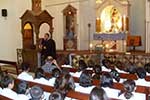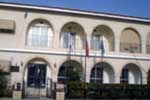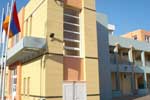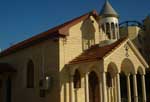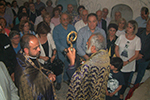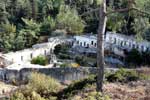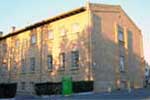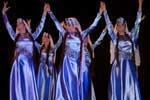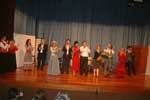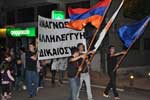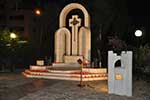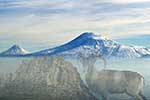|
FACTS
|
The diachronic course of Armenians in Cyprus
Alexander-Michael Hadjilyra
|
|
NATION CREATION
|
- During the 8th century B.C., from the tribes in the western part of the kingdom of Urartu, in the region of present-day Anatolia.
|
|
APPEARANCE IN CYPRUS
|
- In 578 Emperor Justin II during his campaign against Persian Chosroes II captured 10.090 Armenians, of which the 1/3 was transferred here.
|
|
OTHER TRANSFERS FROM
AND TO CYPRUS
|
- More Armenians arrived here during the reign of the Armenian-descended Emperor Heraclius (610-641), in relation to political motives.
- After the liberation of Cyprus, in 965, by Patrician Niketas Chalkoutzes, Armenians settle here as mercenary Frontiersmen.
- Between 1136-1138 the entire population of the city Tel Hamdoun is transferred here.
- In 1185 after the wedding of Isaac II Comnenus with the daughter of Thoros II, Armenian warriors arrive.
- In 1192 after an invitation by Guy De Lusignan.
- About 30.000 Armenians arrive when in 1322 the Saracens occupy little Armenia.
- More Armenians come in 1335 and in 1346, to escape the Mamluk attacks.
- In 1403 another 30.000 Armenians,
- while in 1421 the residents of Seihun migrate here.
- In 1441 Armenians and Syrians from Syria and Cilicia settle in Famagusta.
- A good many of the 40.000 Armenian craftsmen who helped with the capture of Nicosia by the Ottomans remained after 1570-1571.
- Armenians arrive during the first years of the British Era as entrepreneurs and translators.
- About 8.000 Armenian refugees find shelter in Cyprus from the horrific slaughters and the Genocide (1894-1896, 1909 & 1915-1923).
- Exodus after 1925 and between 1962-1965 to Armenia, between 1955-1959 & 1962-1965 to U.K.
- Armenians arrived in Cyprus as refugees from Palestine (1947) & Egypt (1956).
- Armenians also arrived here because of the civil war in Lebanon (1975-1990),
- the Revolution in Iran (1979)
- and the fall of the U.S.S.R. (1991).
|
|
VILLAGES THEY ESTABLISHED
|
- Armenokhori,
- Arminou,
- Kornokipos,
- Patriki,
- Platani,
- Spathariko maybe also Mousere.
- Later on many resided in the ARMENIAN QUARTER.
|
|
CHURCH ESTABLISHMENT
|
- Although we have officially evidence since 1179 (Thaddeus), it appears it was established in 973.
|
|
GENERIC OCCUPATION
|
- Initially mercenaries, knights and warriors,
- later on capable fief owners,
- after that nobles and merchants,
- afterwards businessmen and photographers, translators, doctors, advocates, professors, musicians, shoemakers, stamp makers, locksmiths, tailors, drapers, printers, watchmakers, miners, restaurateurs and merchants.
|
|
POPULATION
|
- Frankish Era: 30.000 - 60.000
- Venetian Era: 30.000
- Ottoman Era: 35.000, rapid reduction.
- 1881: 175,
- 1931: 3.400,
- 1960: 3.600
- 2008: 3.000-3.500
|
|
EDUCATION
|
- Nicosia
- 1870: Vartanantz School for Boys,
- 1902: Shushanian School for Girls,
- 1897-1904: Kurkjian Boarding School,
- 1921 & 1938: Melikian & Ouzounian Varjaranner, they were merged in 1950.
- 1972: Nareg.
- Larnaca
- 1909: Mousheghian Varjaran,
- 1996: new Nareg.
- Limassol
- 1928: Armenian School,
- 2007: new Nareg.
- Famagusta: school,
- Amiandos: nursery.
- Nareg Junior High School: 2005. Nicosia
- MELKONIAN: 1926-2005.
|
|
CHURCHES/MONASTERIES
|
- Sourp Asdvadzadzin - Virgin Mary (Acropolis),
- Sourp Stepanos - Saint Stephen (Larnaca),
- Sourp Kevork - Saint George (Limassol),
- Sourp Amenapergitch - Saviour of All (Acropolis),
- Sourp Haroutune - Resurrection (Ayios Dhometios T),
- Sourp Boghos - Saint Paul (Nicosia T).
- Sourp Asdvadzadzin - Virgin Mary (Nicosia),
- Holy Virgin of Ganchvor - the Caller (Famagusta),
- GARAVANK - SAINT MAKARIOS MONASTERY (Halevga).
- Armenian Evangelical Church (Nicosia)
|
|
CEMETERIES
|
- 1 at Ledra Palace
- 1 in Larnaca,
- 1 in Limassol,
- 1 in Ayios Dhometios,
- 1 in Ayii Trimithias,
- 1 in Famagusta
- + 1 protestant in Larnaca.
|
|
RELIGIOUS IDENTITY
|
- Oriental Orthodox Church with one Patriarch (Catholicos) in Etchmiadzin and one in Antelias.
- They are not Monophysites.
- The mass is celebrated in Armenian.
- Adoration is limited to the kissing the Gospel and the Cross.
- Instead of icons they have the Khackar (cross-stones).
- They have celibate and married priests, and the deacons are laymen.
|
|
PARTICULARITIES
|
- There many Libanahayer (Lebanese Armenians) in Cyprus
- and Hayastantsi (Armenians of Armenia).
- Very few Armenian Cypriots are Evangelicals, Catholics or Jehovah's Witnesses.
|
|
LANGUAGE/WRITING SYSTEM
|
- Their mother tongue is Western Armenian (Arevm'tahayeren),
- however they also speak Greek
- and English, and the older ones Turkish too.
- The Armenian alphabet was invented in 405 by Sourp Mesrob Mashtots and had 36 elements (+2 in the 11th century).
|
|
ACTIVITIES
|
- Printed press: Artsagang - Echo, Azad Tzayn - Free Voice, Lradou, Keghart, electronic (Gibrahayer),
- Associations & Youth clubs (AYMA/DASHNAKTSUTIUN Vs AGBU-PAREKORDZAGAN/ RAMGAVAR, HENCHAGIAN),
- Athletic teams, Dancing groups, formerly scout Systems, hockey Team & Gaydzak,
- Kalaydjian Rest Home for the Elderly.
- Daily radio transmission from CyBC 2 between 17:00-18:00.
|
|
MONUMENTS
|
- Genocide Monuments (Nicosia & Larnaca & destroyed occupied Nicosia),
- Khachkar, Bishop Zareh's bust and Sourp Krikor Naregatsi's statue (Acropolis),
- monument of Krikor & Garabed Melkonian (Aglandjia),
- monument at Magaravank for the visit of Catholicos Sahag II
- Khachkar (Limassol)
|





